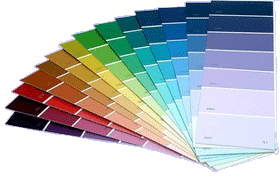If you are going to have a gorgeous room on a budget and you are going to decorate and design it yourself! Think there is no way that's going to happen? All that's standing between you and that gorgeous room is some simple decorating and design basics. When you understand those, you can decorate any room. We actually know more about design than we realise. Have you walked into a room that just "feels" off? Violation of one of these principles just may be the reason. Learning more about design may enable you to figure out what was wrong and make certain you don’t make the same mistake in your home.
The Basics of Colour
Colour can make a room a success or - if totally wrong - can make it a disaster. But the best thing is - it's easily changed and inexpensive. The paint you chose can lighten a room or make it dark and intimate, can be a personal statement or a classic tradition, and can be a neutral palette or a focal point. Just decide which direction you want to go and use the colour principles here to design with a colour.
Using Colour Charts
The colour Chart or swatch is a great tool for home decorating. All colour schemes used in design are based on this. Knowing how to use these and pick colours which harmonise and compliment will help you find a colour scheme that can create a eye-pleasing design to enhance your home.
Your local paint store or DIY store can give you sample colour charts. Find colour combinations, and paint colour formulas that you can take home and plan and experiment with.
Go Green!
Down to earth from Harris Brushes is a inexpensive range of decorating products specially designed to be environmentally friendly. The components of the range are manufactured using either sustainable sources or recycled materials and have been produced to ensure that all parts are biodegradable or recyclable. Simply use and throw away!
More than 35 million paintbrushes are discarded into toxic landfills every year, in the UK alone. This includes over 24 tonnes of Polypropylene, which with no additives is non-biodegradable, toxic to the environment whilst eroding and can take up to 450 years to degrade (dependent on landfill conditions). Whilst Polypropylene has a number of good uses, its key strengths of durability and resistance to fatigue are its enemy when it comes to biodegrading or recycling.
So what are you going to do with that bare room? To figure that out, you need to understand the size of your space, the problems it has, the relationship between one element and another in the space and how the eye perceives those relationships. Understanding these elements are essential when planning your space layout and the placement of the furniture and accessories.
Once you understand how colour and space relationships work, you are ready to put your room together. Fabrics, furniture, and accessories can now be added. You probably have a style in mind that you prefer, so go for it. One last piece of advice: less is more. Only put into the room half of what you think you want. The design will be cleaner, less cluttered and elegant. It will be that gorgeous room that you finally designed yourself!
More than 35 million paintbrushes are discarded into toxic landfills every year, in the UK alone. This includes over 24 tonnes of Polypropylene, which with no additives is non-biodegradable, toxic to the environment whilst eroding and can take up to 450 years to degrade (dependent on landfill conditions). Whilst Polypropylene has a number of good uses, its key strengths of durability and resistance to fatigue are its enemy when it comes to biodegrading or recycling.
Understanding Room Design
So what are you going to do with that bare room? To figure that out, you need to understand the size of your space, the problems it has, the relationship between one element and another in the space and how the eye perceives those relationships. Understanding these elements are essential when planning your space layout and the placement of the furniture and accessories.
Once you understand how colour and space relationships work, you are ready to put your room together. Fabrics, furniture, and accessories can now be added. You probably have a style in mind that you prefer, so go for it. One last piece of advice: less is more. Only put into the room half of what you think you want. The design will be cleaner, less cluttered and elegant. It will be that gorgeous room that you finally designed yourself!









